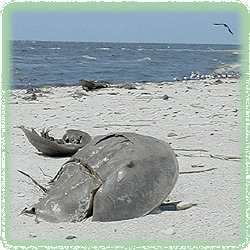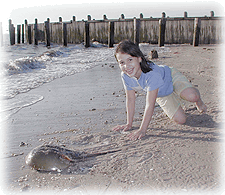 |
|
|||
Objectives
Materials Photographs of the horseshoe crab/shorebird phenomenon Optional: Show the video The Crabs, the Birds, the Bay, available from the NJ Audubon Center for Research and Education —(609) 861-0700. Making Connections The interrelationship between the horseshoe crab and numerous species of shorebirds is well documented. The region of Southern New Jersey along the Delaware Bayshore is famous for being one of the best places to witness the amazing migration of shorebirds that occurs there each spring. The phenomenon is touched on in the film Down Jersey and deserves closer investigation and explanation. Looking at the horseshoe crab as a keystone species is one way to understand the intricacies of nature and the environment. Background See the other Activities in this guide related to the Horseshoe Crab and Shorebirds. The Horseshoe Crab as a Keystone Species Concept of a Keystone Species The same is true in nature. If a keystone species becomes extinct from an environment or ecosystem, the species supported will disappear as will other species that are dependent. These keystone species can occur at any level in the ecosystem. They can be plants or herbivores (plant eaters), carnivores (meat eaters), or detrivores (waste eaters). Carnivores may be important in keeping the populations of other species under control. Herbivores can shape the environment in which other species live. Some important plants support particular insect species that are prey for the birds and bats that disperse the seeds of plants and other organisms. The Horseshoe Crab and the Delaware Bay What makes this odd prehistoric creature a keystone species? At the same time the horseshoe crabs are laying their eggs, nearly a million shorebirds converge on the Delaware Bay each spring on their northward migration. The Bay is the second largest feeding stopover in the western hemisphere for north-bound shorebirds. Many of these shorebirds travel thousands of miles nonstop from Central and South America. They arrive thin and hungry and rely on the feast of tiny green horseshoe crab eggs to regain their weight and energy reserves for the rest of their trip to summer nesting grounds in Canada and the Arctic. As many as 30 species of shorebirds cram the shoreline in late May trying to double their body weights. The four most common species are the red knot, sanderling, ruddy turnstone, and semipalmated sandpiper, and they account for as much as 97 percent of the shorebirds that stop over in the Delaware Bay. It has been estimated that a sanderling bird weighing 50 grams on arrival will eat one horseshoe crab egg every five seconds for 14 hours per day. Clearly, if the horseshoe crab were not there to provide the eggs that are a major food source for these migrating bird species, there would be a major effect on the number of birds migrating and their ability to survive. Since these birds come from such great distances, anything that affects the population and habitat of the horseshoe crabs in the Delaware Bay has implications for these other species thousands of miles away.
Warm Up Describe the connection between the horseshoe crab and shorebirds. Utilize the background information provided or any of the other related activities in this guide. The Activity Tell students that they are going to demonstrate the concept of a keystone species. NOTE: You may want to have the class divide into three groups and challenge each group to demonstrate one of options #1-3. Option #4 requires a large area and group of students. Optional Activities:
Wrap Up Summarize the concept of a keystone species and relate the significance of the horseshoe crab to the survival of migrating shorebirds. Action Find out more about this natural phenomenon. Visit a viewing area in late May to witness the migration. Contact the Endangered and Nongame Species Program to find out what you can do to help! Assessment As homework, have students describe what a keystone species is and why the horseshoe crab is considered one. Extensions Using the resources listed below, have students research other keystone species. Or, find out what is being done in the Down Jersey region to protect the horseshoe crab population and their spawning areas. Please download the PDF for the Lesson Plan. NJDEP — Endangered and Nongame Species Program Bagheera website: World Resources Institute The Delaware Estuary: Rediscovering a Forgotten Resource New Jersey Audubon Society Center for Research and Education* * This is where to get the video The Crabs, the Birds, the Bay |
|||

 Setting
Setting Procedure
Procedure